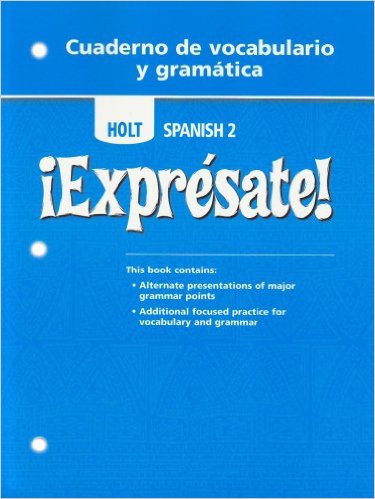
All Solutions
Page 43: Vocabulario
2. a
3. b
4. c
5. c
6. a
7. b
We must remember vocabulary 2 from this chapter.
Among the words on the box we can find **me dio un calambre** (it gave me a cramp), which, seeing the sequence of the text and the part of the body in which it hit, makes sense.
Here we can assume that since Arturo got a cramp, he may have lost his balance. With this, the words on the box that make sense could be **me caí** (I fell) and **me lastimé** (got hurt), because his ankle is mentioned.
After his cramp, fall and ankle injury, we can think that the words that make sense here is **me duele** (it hurts) because it must hurt Arturo a lot.
When leaving the water it is common for people to cut their feet if there are sharp objects in the sand. With that in mind, the words that make sense here are **me corté** (I cut myself).
Here we are talking about the toe that Arturo cut off.
If a injury is not cleaned, it can become infected. That’s why the words that make sense here are **lo tengo infectado** (It’s infected).
Let’s think about the beach. If a person does not protect himself from the sun he can get sunburned.
As Arturo did not wear a cap, he could suffer burns. Therefore, the words that should go here are **me quemé** (I get burned)
When sunburn is very strong, it can have very unpleasant effects. The last word on the box and the one that makes sense here is **hinchada** (swollen).
(2) Me caí.
(3) Me lastimé.
(4) Me duele.
(5) Me corté.
(6) Lo tengo infectado.
(7) Me quemé.
(8) Hinchada.
Remember that we need to conjugate the verbs in the first person and in the appropriate tense.
In this case, the nurse asks us *¿Qué tienes?* (What’s wrong?). With the given words we can describe two situations: that we cut our lip (in the past) and that we have it infected (in the present).
To describe that we cut our lip in the past, we must conjugate the verb *cortar* in the preterite tense.
Let’s see what the answer be like:
|Spanish |English |
|–|–|
|Me corté el labio y lo tengo infectado. |I cut my lip and it is infected. |
Let’s see that the question *¿Qué te pasó?* (What happened to you?) is in the past tense, so we can assume that at that moment we already broke our leg. We must conjugate the verb *romper* in the preterite tense.
|Spanish |English |
|–|–|
|Me rompí la pierna patinando. | I broke my leg skating.|
In this case, the nurse’s question is *¿Qué tienes?* (What’s wrong?). Let’s see that among the words are *darse un golpe* (bump). We might think that the answer should be in the present tense as well as the question, but it would not make sense to tell the nurse that we are taking a hit.
We must conjugate the verb *dar* in the preterite tense because it is something that already happened. Let’s see the answer:
|Spanish |English |
|–|–|
|Me di un golpe en la mejilla. | I took a hit on the cheek.|
Again, the nurse asks us *¿Qué te pasó?* (What happened to you?). We must conjugate the verb *torcer* in the preterite tense to indicate that it is something that has already happened.
|Spanish |English |
|–|–|
| Me torcí el tobillo. |I twisted my ankle. |
In this case, we must conjugate the verb *dar* in the preterite tense because seeing the question, the verb and the context (remembering sentence # 3) we can assume that it is something that has already happened.
|Spanish |English |
|–|–|
| Me di un golpe en el codo con la pared. | I hit my elbow on the wall. |
In this case, the question is *¿Qué tienes?* (What’s wrong?) and between the parenthesis words we have *tener un calambre*.
Unlike the previous sentences, the answer in this case will be in the present tense. This is because, in the case of having a cramp, it would not make sense for us to conjugate the verb *tener* in the preterite tense because if it has already passed there will be no pain or symptoms.
If the nurse notices that something is happening to us and she asks us, we can assume that it is because we have the cramp at that moment. The answer would be:
|Spanish |English |
|–|–|
|Tengo un calambre en la pierna. | I have a leg cramp.|
Then we must give them advice on what to do to feel better.
The answer would be the following:
|Spanish |English |
|–|–|
| Me duele la cabeza. Tómate una pastilla. | My head hurts. Take a pill. |
To ease the symptoms, she could take some cold pills and rest.
|Spanish |English |
|–|–|
|Estoy resfriada. Tómate una pastilla para el resfriado y descansa. | I have a cold. Take a cold pill and rest.|
For this, we may recommend that you apply an ointment to reduce swelling.
|Spanish |English |
|–|–|
|Me duele la mejilla. Ponte un ungüento. | My cheek hurts. Put on ointment.|
When this happens, it is best to apply a bandage to ensure that the ankle is in its correct position.
| Spanish| English|
|–|–|
| Me torcí el tobillo, me duele. Ponte este vendaje.| I sprained my ankle, it hurts. Put this bandage on.|
|Spanish | English|
|–|–|
|Me corté el dedo. Ponte una curita. |I cut my finger. Put on an adhesive bandage. |

